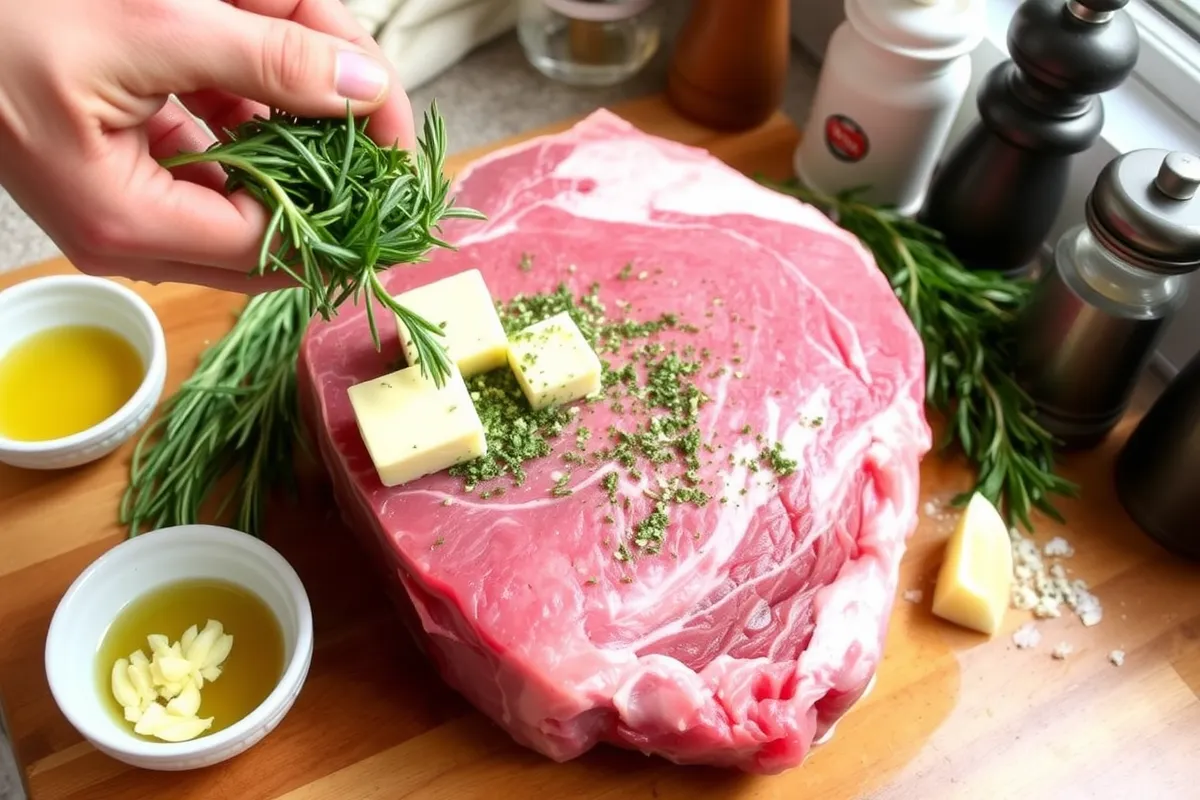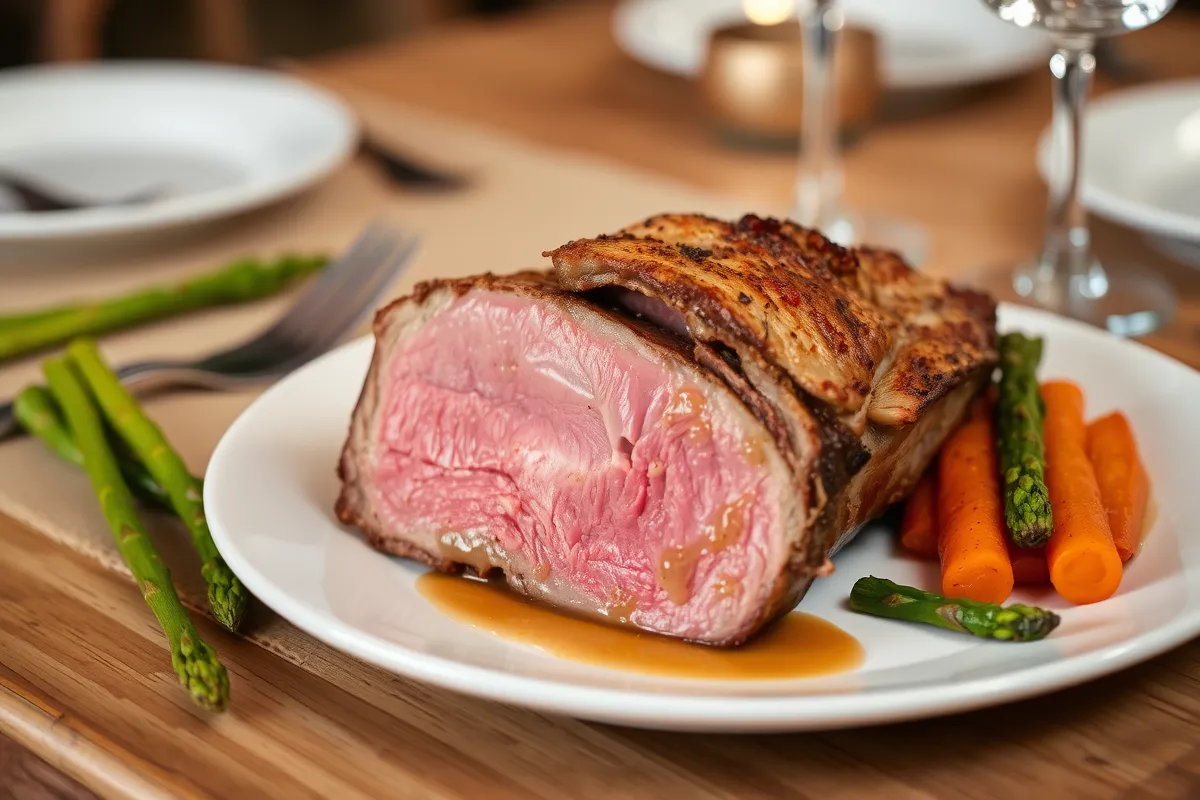Cooking a boneless prime rib to perfection is easier than you think! Whether you’re hosting a festive lunch, dinner or just craving a hearty meal, this article will walk you through every step of the process—from selecting the perfect cut to mastering the art of seasoning, cooking, and serving. With detailed tips, troubleshooting advice, and answers to common questions, this guide ensures your roast will turn out juicy, flavorful, and absolutely stunning. Let’s dive in!
Introduction to Boneless Prime Rib
What is a Boneless Prime Rib?
A boneless prime rib is a showstopping cut of beef known for its rich marbling and tender texture. Unlike its bone-in counterpart, this version offers the same luxurious flavor without the hassle of carving around the ribs. It’s essentially a ribeye roast but cooked whole instead of sliced into steaks.
Why Choose Boneless Over Bone-In?
Sure, bone-in prime rib has its charm, but the boneless version is all about simplicity. Without the bones, it’s easier to season, cook evenly, and carve into uniform slices. Whether you’re new to cooking large cuts of beef or prefer a fuss-free option, boneless prime rib is the way to go.
Another benefit? Boneless prime rib recipes often cook slightly faster, making it ideal when time is of the essence. And let’s be honest—nobody’s complaining about having less mess to clean up after the meal!
Nutritional Benefits of Prime Rib
Prime rib isn’t just a delicious indulgence; it’s also packed with nutrients. This cut is an excellent source of protein, essential amino acids, and iron. Additionally, its fat content contributes to its buttery flavor, but don’t worry—moderation is key!
For those looking for a balanced meal, pairing prime rib with veggie-packed sides like roasted asparagus or a fresh salad adds a healthy touch. And with a little planning, it’s easy to enjoy this indulgence guilt-free.
To help you make informed dietary choices, here’s the approximate nutritional breakdown for a boneless prime rib recipe per 100g serving:
| Nutrient | Amount (Per 100g) |
|---|---|
| Calories | 294 kcal |
| Protein | 24.0 g |
| Total Fat | 21.0 g |
| Saturated Fat | 9.0 g |
| Cholesterol | 80 mg |
| Sodium | 60 mg |
| Iron | 2.7 mg |
- This cut is rich in protein, making it ideal for muscle repair and growth.
- It has a moderate amount of fat, which contributes to its tender texture and rich flavor.
- Boneless prime rib also provides essential minerals like iron, supporting healthy blood and energy levels.
Choosing the Best Cut for Your Boneless Prime Rib
How to Select the Perfect Cut
Choosing the right cut is critical for preparing a boneless prime rib recipe that wows your guests. Look for a roast with excellent marbling—those streaks of fat woven throughout the meat are what deliver that rich, buttery flavor. You’ll typically find boneless prime rib labeled as a “ribeye roast” or “prime rib roast” at your butcher or local market.
When buying, aim for about 1 pound per person if this is your main dish. If you’re hosting a smaller gathering, request a smaller section of the roast. For a truly premium experience, splurge on USDA Prime meat for its superior tenderness and marbling.
Understanding Grades of Meat (Prime vs. Choice)
Meat grading can seem confusing, but it boils down to fat content and tenderness. Prime-grade beef is top-notch and contains the most marbling, making it juicier and more flavorful. Choice-grade beef is still a fantastic option and more budget-friendly.
When selecting your cut, remember that even Choice-grade beef can shine with the right preparation. For those wondering about Wagyu or grass-fed beef, these options offer unique flavors but might require slightly different cooking techniques.
Best Practices for Storing Meat Before Cooking
Proper storage can make or break your boneless prime rib. If you’re not cooking it immediately, store it in the coldest part of your refrigerator, ideally between 32–40°F. To maintain freshness, keep the roast wrapped tightly in butcher paper or vacuum-sealed packaging.
Before cooking, allow the meat to sit at room temperature for at least an hour. This step ensures even cooking and avoids the dreaded cold center.
Check out this guide to perfect roasts for additional tips on prime rib storage and prep!
Essential Tools and Ingredients for Boneless Prime Rib
Kitchen Tools You’ll Need
You don’t need a fancy setup to master a boneless prime rib recipe, but a few tools are indispensable. A meat thermometer is your best friend—it ensures your roast hits that perfect medium-rare (about 130°F). You’ll also want a roasting pan with a rack to allow air circulation and even cooking.
Other handy tools include:
- A sharp carving knife for picture-perfect slices
- Aluminum foil for tenting the roast
- A basting brush for applying marinades or butter
The Essential Ingredient Checklist
The beauty of prime rib lies in its simplicity, but seasoning it right elevates the dish. Here’s what you’ll need:
- The roast itself: A well-marbled boneless prime rib
- Salt and pepper: The foundation of flavor
- Garlic and fresh herbs: Think rosemary, thyme, and parsley
- Butter or olive oil: Helps create that golden-brown crust
Optional extras include Dijon mustard for a tangy crust or smoked paprika for depth. With these staples in hand, your roast is ready to become the centerpiece of your table.
Preparing Your Boneless Prime Rib for Cooking

Thawing and Bringing to Room Temperature
The secret to a perfect boneless prime rib recipe lies in preparation. If your roast is frozen, ensure it’s fully thawed before cooking. Thawing in the fridge is the safest method, but allow at least 24 hours for every 5 pounds of meat. In a pinch, you can use cold water to speed things up, but never thaw at room temperature—it risks uneven defrosting and potential bacterial growth.
Once thawed, let the roast sit at room temperature for 1–2 hours before cooking. This step ensures even cooking, avoiding a cold center while preventing the outer layers from overcooking.
Marinating and Seasoning Techniques
Prime rib shines with just salt and pepper, but adding a few extra layers of flavor doesn’t hurt. For a flavorful marinade, combine olive oil, minced garlic, rosemary, thyme, and a splash of Worcestershire sauce. Rub it generously over the roast and let it sit for 4–6 hours or overnight in the fridge.
If you prefer a simpler approach, a dry rub with kosher salt, black pepper, garlic powder, and smoked paprika works wonders. Don’t forget to season the meat liberally—prime rib is thick, and you want the flavors to permeate every bite.
The Importance of Resting Before Cooking
Allowing the roast to rest after marinating is key. Not only does it let the seasoning soak in, but it also ensures that the roast reaches an even internal temperature. Before placing the roast in the oven, pat it dry with paper towels to help achieve that sought-after crispy crust.
Cooking Methods for Boneless Prime Rib
Classic Oven-Roasting Method
Oven-roasting is the most common way to cook a boneless prime rib recipe. Preheat your oven to 450°F and sear the roast for 15 minutes to lock in juices. Then, lower the temperature to 325°F and continue cooking until the internal temperature reaches 130°F for medium-rare.
Remember to use a meat thermometer to monitor the roast closely. Rest the meat for 20–30 minutes before carving to allow the juices to redistribute, ensuring every bite is tender and juicy.
Sous Vide Technique
For precision cooking, sous vide is unbeatable. Vacuum-seal your seasoned roast and cook it in a water bath at 132°F for medium-rare, typically for 6–8 hours. Once done, sear it in a hot skillet or under the broiler to develop a crust.
Grilling for a Smoky Flavor
For those craving a smoky twist, grilling is a fantastic option. Preheat your grill to 250°F for indirect heat, then place the roast on the cooler side. Cook until the internal temperature reaches your desired doneness, then sear it over high heat for a beautiful crust.
Slow-Roasting for Tender Results
Slow roasting at 225°F ensures a melt-in-your-mouth texture. This method takes longer but delivers consistent results with minimal effort. Pair it with a reverse sear at the end for the perfect exterior.
Choosing the Right Cooking Temperature and Time
The ideal cooking time and temperature depend on your desired doneness:
- Rare: 120–125°F (12–14 minutes per pound)
- Medium-rare: 130–135°F (15–17 minutes per pound)
- Medium: 140–145°F (18–20 minutes per pound)
Always let the roast rest after cooking—it’s the secret to locking in moisture.
Achieving the Perfect Crust
Creating a Garlic-Herb Crust
The crust is what transforms a boneless prime rib recipe from good to unforgettable. A garlic-herb crust is a classic choice, providing a savory, aromatic complement to the rich meat. To make it, mix softened butter with minced garlic, chopped rosemary, thyme, and parsley. Add a pinch of salt and freshly cracked black pepper to taste.
Generously spread this mixture over the entire roast, ensuring an even coating. The butter helps the herbs stick while also aiding in browning. As the roast cooks, the herb mixture forms a crispy, flavorful layer that contrasts beautifully with the tender meat inside.
For added depth of flavor, sprinkle a little smoked paprika or Dijon mustard onto the roast before applying the garlic-herb butter. These subtle additions elevate the crust without overpowering the beef’s natural taste.
Tips for Using a Crust While Retaining Juiciness
Achieving a crisp crust without drying out the roast is a delicate balance. Start by searing the roast at high heat (450°F) for about 15 minutes. This step locks in the juices and kickstarts the crust’s formation.
As the roast continues to cook at a lower temperature, baste it occasionally with pan drippings or melted butter. This keeps the crust moist and prevents it from burning. Finally, let the roast rest uncovered after cooking. This allows the crust to set while ensuring the meat retains its natural juices.
Slicing and Serving Boneless Prime Rib

How to Slice Like a Pro
Carving your boneless prime rib recipe properly ensures every bite is as delightful as the next. Start by using a sharp carving knife to cut against the grain. This shortens the muscle fibers, making each slice tender and easy to chew.
Slice the roast into ½-inch to 1-inch thick pieces, depending on your preference. For a large gathering, thinner slices go further, while thicker cuts provide a more indulgent experience. Always use a carving board with a groove to catch the juices—these are perfect for drizzling over the meat.
Perfect Side Dishes to Pair with Prime Rib
A great boneless prime rib deserves equally stellar side dishes. Traditional options like creamy mashed potatoes, roasted Brussels sprouts, or Yorkshire pudding are crowd-pleasers. For something lighter, pair the roast with a crisp salad or roasted asparagus.
Want to try something unique? Consider garlic-Parmesan pasta or a tangy cranberry sauce for a delightful contrast to the richness of the roast. These sides not only complement the flavors but also create a balanced, memorable meal.
For more side dish ideas, explore Grate Recipes’ collection of holiday-inspired recipes.
Troubleshooting and Common Mistakes
Avoiding Overcooking or Undercooking
One of the most common issues with a boneless prime rib recipe is uneven cooking. Overcooking can dry out your roast, while undercooking leaves it cold in the center. To avoid this, always rely on a meat thermometer instead of guesswork. Insert the thermometer into the thickest part of the roast, away from fat or bone, for an accurate reading.
Another key tip is to let your roast come to room temperature before cooking. Starting with cold meat leads to uneven cooking, with the outside overcooking while the inside lags behind.
Fixing a Dry Prime Rib
Accidentally overcooked your roast? Don’t panic—there’s still hope! Slice the meat thinly and drizzle it with warm pan drippings, beef stock, or a buttery sauce to restore some moisture. Serving it with a rich au jus or horseradish cream can also mask dryness.
Dealing with Uneven Cooking
Uneven cooking often results from skipping the resting step before cooking or using improper oven settings. To fix this, consider a reverse-sear technique: slow-roast at a low temperature first, then finish with a high-heat sear. This method ensures the roast cooks evenly while achieving a crisp crust.
FAQs About Boneless Prime Rib Recipe
What’s the Ideal Cooking Temperature?
For a perfectly cooked boneless prime rib recipe, aim for 130°F for medium-rare, 140°F for medium, or 120°F for rare. Always let the roast rest for at least 20 minutes after cooking—this allows the internal temperature to rise slightly while the juices redistribute.
How Long Should Prime Rib Rest After Cooking?
Resting is crucial for maintaining juiciness. Let your roast sit for 20–30 minutes, tented lightly with foil. This prevents the juices from spilling out when you carve, keeping the meat moist and tender.
Can You Cook Prime Rib From Frozen?
Cooking from frozen is not recommended, as it leads to uneven results. Always thaw the roast completely in the fridge, which takes about 24 hours for every 5 pounds of meat.
How to Reheat Leftovers Without Drying Them Out?
Reheat slices in a low oven (300°F) wrapped in foil with a splash of beef stock or drippings. Alternatively, use a skillet over low heat for a quick and flavorful warm-up.
Conclusion and Final Tips for Perfecting Your Boneless Prime Rib
Recap of Key Steps
Mastering the art of the boneless prime rib recipe might seem intimidating, but with the right approach, it’s completely achievable. Start by choosing a high-quality cut of meat with excellent marbling, and take the time to prepare it properly—this includes thorough seasoning and allowing it to rest before cooking.
The cooking process, whether you prefer oven-roasting, grilling, or sous vide, is all about precision. Always use a meat thermometer to ensure your roast reaches your desired doneness. Don’t forget to rest the meat after cooking—it’s the secret to keeping it juicy and flavorful. And finally, slicing against the grain and pairing your roast with the perfect side dishes will ensure your meal is a crowd-pleaser.
Bonus Tips for Beginners
If you’re new to cooking prime rib, start with the classic oven-roasting method—it’s straightforward and yields great results. Keep an eye on the internal temperature and baste the roast occasionally for a perfectly caramelized crust.
Experimenting with flavors is also a great way to add a personal touch. Try different herb blends, rubs, or marinades to suit your taste. And remember, practice makes perfect—the more you cook prime rib, the more confident you’ll become.
For more inspiration and recipes, explore Grate Recipes for ideas to elevate your cooking game.

